
Starfish or sea stars are star-shaped echinoderms belonging to the class Asteroidea. Common usage frequently finds these names being also applied to ophiuroids, which are correctly referred to as brittle stars or basket stars. Starfish are also known as asteroids due to being in the class Asteroidea. About 1,900 species of starfish live on the seabed in all the world's oceans, from warm, tropical zones to frigid, polar regions. They are found from the intertidal zone down to abyssal depths, at 6,000 m (20,000 ft) below the surface.
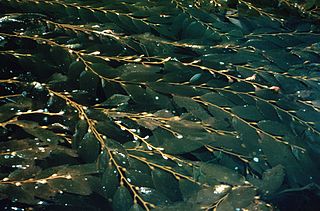
Macrocystis is a monospecific genus of kelp with all species now synonymous with Macrocystis pyrifera. It is commonly known as giant kelp or bladder kelp. This genus contains the largest of all the Phaeophyceae or brown algae. Macrocystis has pneumatocysts at the base of its blades. Sporophytes are perennial and the individual may live for up to three years; stipes/fronds within a whole individual undergo senescence, where each frond may persist for approximately 100 days. The genus is found widely in subtropical, temperate, and sub-Antarctic oceans of the Southern Hemisphere and in the northeast Pacific. Macrocystis is often a major component of temperate kelp forests.

The Echinasteridae are a family of starfish in the monotypic order Spinulosida. The family includes eight genera and about 133 species found on the seabed in various habitats around the world.
Nacella macquariensis is a species of true limpet, a marine gastropod mollusc in the family Nacellidae. It is found on the lower foreshore and in the shallow sub-littoral zone of certain islands in the southern Indian Ocean and Southern Ocean.

The marine snail Norrisia norrisii is a medium-sized gastropod mollusk within the family Tegulidae. It has several common names, including Norris's top snail, Norris's topsnail, norrissnail, smooth brown turban snail, or kelp snail. It was first described by G.B. Sowerby I under the name Trochiscus norrisii. It is the only species in the genus Norrisia.

Aquaculture of giant kelp, Macrocystis pyrifera, is the cultivation of kelp for uses such as food, dietary supplements or potash. Giant kelp contains iodine, potassium, other minerals vitamins and carbohydrates.

Leptasterias hexactis is a species of starfish in the family Asteriidae, commonly known as the six-rayed star. It is found in the intertidal zone of the western seaboard of the United States. It is a predator and is unusual among starfish in that it broods its eggs and young.
Anasterias rupicola is a species of starfish in the family Asteriidae. It is found in shallow waters in the Southern Ocean and sub-Antarctic Indian Ocean.
Stylasterias is a genus of starfish in the family Asteriidae. Stylasterias forreri, the velcro star, is the only species in the genus. It is found on the Pacific coast of Canada and the United States.
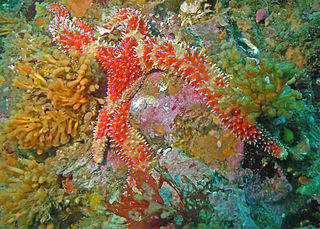
Orthasterias is a genus of sea stars in the family Asteriidae. Orthasterias koehleri, the rainbow star or red-banded sea star, is the only species in the genus. It is found in the North Pacific Ocean.

Leptasterias tenera is a species of starfish in the family Asteriidae. It is found on the eastern coast of North America.

Leptasterias polaris, the polar six-rayed star, is a species of starfish in the family Asteriidae. It is found in cold waters in the northwest Atlantic Ocean and in polar regions.

Pteraster militaris, the wrinkled star, is a species of starfish in the family Pterasteridae. It is found in the northern Pacific Ocean, the Arctic Ocean, the Barents Sea, and the northern Atlantic Ocean.

Marthasterias is a genus of starfish in the family Asteriidae. Both species in the genus are commonly known as the spiny starfish.
Trophodiscus almus is a species of starfish in the family Astropectinidae. It is found in fairly deep waters in the Sea of Okhotsk, the Sea of Japan and around the Japanese island of Hokkaido. It is very unusual among starfish in that it broods its young on its upper surface. Its common name in Japanese is "Komochi-momiji".
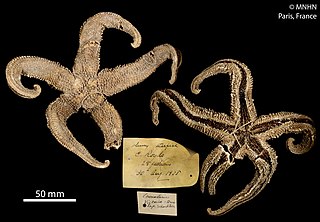
Diplasterias brucei is a species of starfish in the family Asteriidae. It is found in the Pacific Ocean and Southern Ocean. It is a predator and scavenger and is unusual among starfish in that it broods its young.
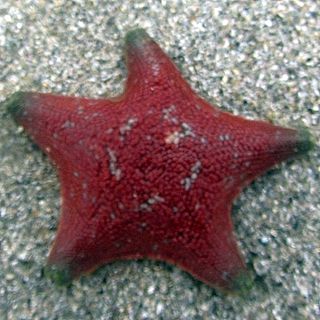
Patiria chilensis is a species of starfish in the family Asterinidae. It is found in the southeastern Pacific Ocean along the coasts of South America. It is a broadly pentagonal, cushion-like starfish with five short arms.

Stichaster striatus, the common light striated star, is a species of starfish in the family Stichasteridae, found in the southeastern Pacific Ocean. It was first described by the German zoologists Johannes Peter Müller and Franz Hermann Troschel in 1840.
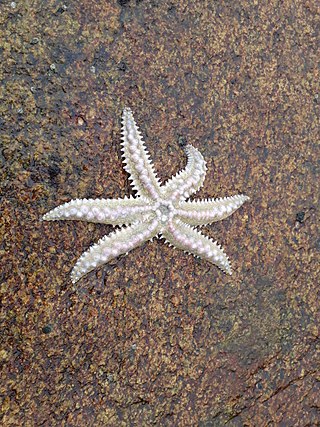
Meyenaster is a genus of starfish in the family Asteriidae. It is a monotypic genus and the only species is Meyenaster gelatinosus which was first described by the Prussian botanist and zoologist Franz Julius Ferdinand Meyen in 1834. It is found in the southeastern Pacific Ocean on the coasts of South America.

Labidiaster radiosus, the fragile sticky ray star, is a large species of starfish in the family Heliasteridae and was first described by Lütken in 1871. It is found in the waters of southern South America to Sub-Antarctica and the Antarctic Peninsula.
















